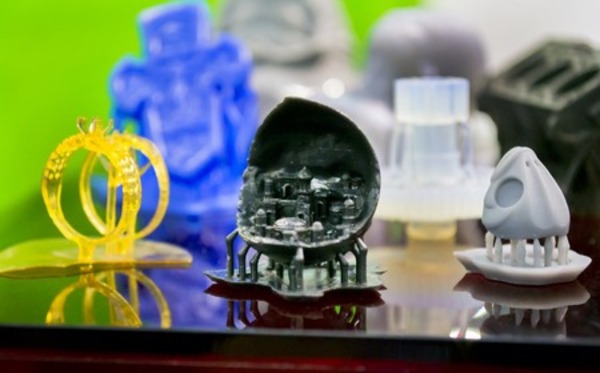Are you curious about how resin 3D printing works? Well, you’re in luck! In this article, we’ll take you through the fascinating process of creating high-quality 3D prints using resin.
With UV lasers or LED lights, the liquid resin is solidified layer by layer, resulting in smooth surfaces perfect for post-processing.
You can easily order resin 3D prints online, choosing from a variety of resins and receiving instant pricing.
Just remember, safety is key when handling and disposing of resin due to its toxins.
Get ready to dive into the world of resin 3D printing!
The Technology Behind Resin 3D Printing
The technology behind resin 3D printing involves using UV lasers to solidify liquid polymer layers. This process offers several advantages.
First, resin 3D printing allows for printing at a lower layer height, resulting in better details and smoothness in the final print. Additionally, the whole layer curing method ensures better fusion between layers, leading to stronger prints. Resin 3D printing also offers a wide range of materials, such as high-strength and flexible resins, providing versatility in print applications.
When troubleshooting resin 3D prints, it is important to consider factors such as resin viscosity, exposure time, and curing settings. Adjusting these parameters can help achieve optimal print quality.
With its advanced technology and material options, resin 3D printing offers a promising solution for high-quality, detailed prints.
The Process of Resin 3D Printing
During resin 3D printing, a computer-controlled UV laser solidifies liquid polymer layers, creating the desired object.
Resin 3D printing offers several advantages over filament printers. It allows you to print at a lower layer height, resulting in better details and smoothness. The whole layer curing process ensures better fusion between layers, resulting in a stronger final print. Additionally, resin 3D printers offer a wide range of high-strength and flexible resins to choose from.
When it comes to the key components of a resin 3D printer, you’ll find a UV laser, a vat to hold the liquid resin, a build platform for printing, and a computer-controlled system to control the entire process.
Some popular resin 3D printer models include the Elegoo Mars Pro, Anycubic Photon Mono X, and Formlabs Form 3, each offering unique features and capabilities.
Different Types of Resins Used in 3D Printing
Customers can choose from four different Stereolithography-based resins offered by Materialise for their 3D prints. Each type of resin has unique properties that make it suitable for different applications.
Mammoth Resin is designed for large prints, with the ability to produce parts up to 2100x700x800 mm in size.
Transparent Resin offers translucency and can be ordered in various colors.
Gray Resin is a versatile option that works well for small- and mid-size models.
The newest addition, Standard Resin, delivers detailed results at a budget-friendly price.
When selecting a resin for your 3D prints, consider factors such as the desired level of transparency, size of the print, and budget.
Materialise offers a range of resins to cater to different needs and preferences.
Characteristics of Resin 3D Prints
Resin 3D prints have smooth surfaces that are ideal for post-processing, such as hand- or spray-painting. The advantage of Toto Macau resin 3D printing is that it allows for high levels of detail and precision, resulting in high-quality prints. These characteristics make resin prints suitable for various applications, including prototyping, jewelry making, and architectural models.
The smooth surface of resin prints enhances the final appearance of the printed object and allows for easy paint adhesion. With resin prints, you can achieve intricate designs and fine details that may not be possible with other printing methods. Additionally, resin prints are durable and can withstand wear and tear, making them suitable for functional parts and artistic creations.
Whether you’re a hobbyist or a professional, resin 3D printing offers endless possibilities for creating stunning and customizable objects.
Ordering Resin 3D Prints
To order your resin 3D prints, simply upload your 3D files and choose from a wide range of available resins. Materialise offers different resin types, each with its own benefits.
Mammoth Resin is perfect for large prints, while Transparent Resin allows for various colors and is great for spray-painting. Gray Resin is versatile and popular among scale modelers, and Standard Resin provides detailed results at an affordable price.
When considering the cost of resin prints, it’s important to note that the price can vary depending on the size and complexity of the print. Additionally, resin prints offer smooth surfaces that are ideal for post-processing techniques such as hand-painting or spray-painting.
Comparison of Resin 3D Printing Technologies
Stereolithography (SLA) is the first 3D printing technology that was patented 40 years ago. When comparing resin 3D printing technologies, there are several factors to consider.
One advantage of SLA is the ability to print at a lower layer height, resulting in better details and smoothness. SLA printers use a UV laser to cure the resin, ensuring better fusion between layers.
On the other hand, Digital Light Processing (DLP) technology uses a digital projection surface as the light source, allowing for faster printing times. Masked Stereolithography (MSLA) or Liquid Crystal Display (LCD) technology also offers smooth surfaces and faster printing times compared to SLA. However, curved surfaces may appear boxy with LCD and MSLA technology.
When choosing a resin for 3D printing, it is important to consider the specific requirements of your project, such as strength or flexibility, and select a resin that meets those needs.
Stereolithography (SLA) in Resin 3D Printing
When using SLA technology in your 3D printing process, you can expect high-quality output and smooth surfaces. SLA, or Stereolithography, offers several advantages in resin 3D printing.
Compared to DLP, SLA allows for printing at a lower layer height, resulting in better details and smoothness. SLA also utilizes whole layer curing, improving the fusion between layers. Additionally, SLA printers offer a wide range of high-strength and flexible resin options.
When comparing SLA and DLP, SLA printers use UV lasers as the light source, while DLP printers use a digital projection surface. SLA printers, such as the Elegoo Mars Pro, Anycubic Photon Mono X, and Formlabs Form 3, are popular choices with various features and pricing options.
Overall, SLA technology provides excellent results and a reliable printing experience in resin 3D printing.
Digital Light Processing (DLP) in Resin 3D Printing
Now let’s explore the advantages of Digital Light Processing (DLP) in resin 3D printing.
DLP, similar to SLA, uses a digital projection surface as the light source. However, DLP printers project the image of a complete layer at once, resulting in faster printing times. The use of a digital micromirror device (DMD) allows for precise control of where the light should be projected. DLP printers create layers using pixels and voxels, with the building platform moving between each layer.
When comparing DLP to SLA in resin 3D printing, DLP offers faster printing speeds and requires fewer additional components. However, DLP may experience decreased quality in larger print areas.
Some popular DLP printer models include the Elegoo Mars Pro, Anycubic Photon Mono X, and Formlabs Form 3. These printers offer various features and have become more affordable over time.
Liquid Crystal Display (Lcd) / Msla in Resin 3D Printing
If you’re considering resin 3D printing, you should know that Liquid Crystal Display (LCD) or MSLA technology uses UV light from LEDs shining through an LCD screen to solidify the layers of your print at once.
LCD technology offers several advantages in resin 3D printing. Firstly, it allows for faster printing times compared to Digital Light Processing (DLP) technology. Secondly, LCD printers offer smoother surfaces, resulting in higher quality prints. Additionally, LCD technology does not require the use of a digital micromirror device (DMD) like DLP printers, simplifying the printing process.
When comparing DLP and LCD in resin 3D printing, the main differences lie in the light sources used and the printing speed.
However, regardless of the technology used, proper resin handling is crucial. Resins contain toxins and should be handled, stored, and disposed of safely to ensure personal safety and environmental protection.
Handling and Storage of Resin in 3D Printing
Proper handling and storage of resin in 3D printing is essential for personal safety and environmental protection. When working with resin, it’s important to take safety precautions to avoid harm. Make sure to wear protective clothing, gloves, goggles, and masks to protect yourself from potential hazards. Nitrile gloves are recommended for chemical resistance and to prevent direct contact with the resin. Goggles will safeguard your eyes from splashes.
To ensure the longevity of your resin, it’s crucial to store it properly. Keep the resin in black, lightproof containers to prevent reactions with UV light. Store the containers in a dark place, away from sunlight.
Proper Disposal of Resin in 3D Printing
When disposing of resin in 3D printing, it is important to remember a few key steps. First, make sure to fully cure any faulty printouts before throwing them away. This is important to prevent any potential environmental impact. Secondly, taking precautions during resin disposal is essential. This includes safe handling and storage of the resin. It is crucial to wear protective clothing, gloves, goggles, and masks when handling resin to prevent skin contact and irritation. Additionally, it is important to store the resin in black, lightproof containers away from sunlight. This helps to avoid premature curing. During printing, it is recommended to use isopropyl alcohol to clean spills and the printing equipment. After printing, make sure to clean the 3D printed object and equipment with alcohol as well. Before disposal, it is crucial to ensure that the resin is completely dried on any surface. Faulty printouts should be fully cured before disposing of them in conventional waste. It is important to avoid pouring resin into drains to prevent any potential environmental damage. For proper disposal options, it is best to contact local waste or recycling centers.



